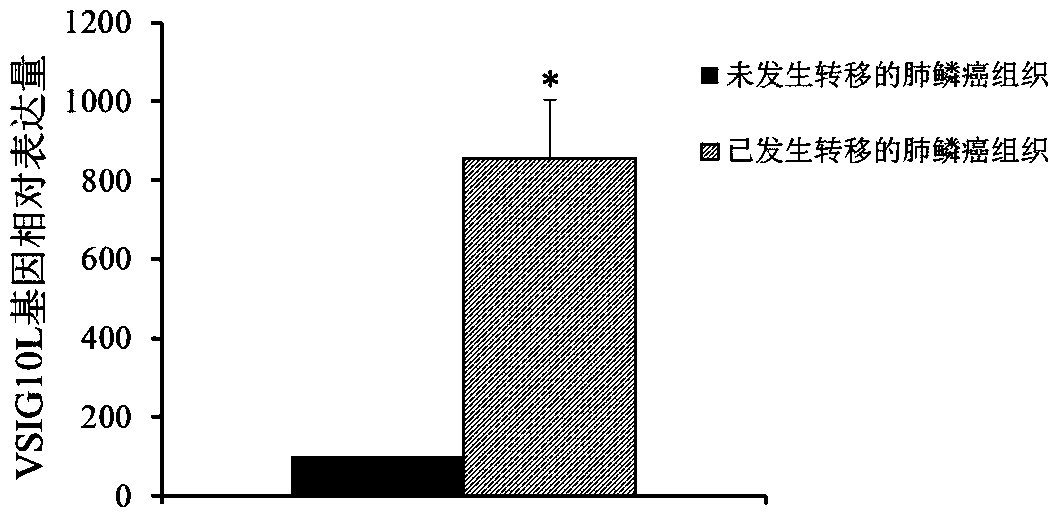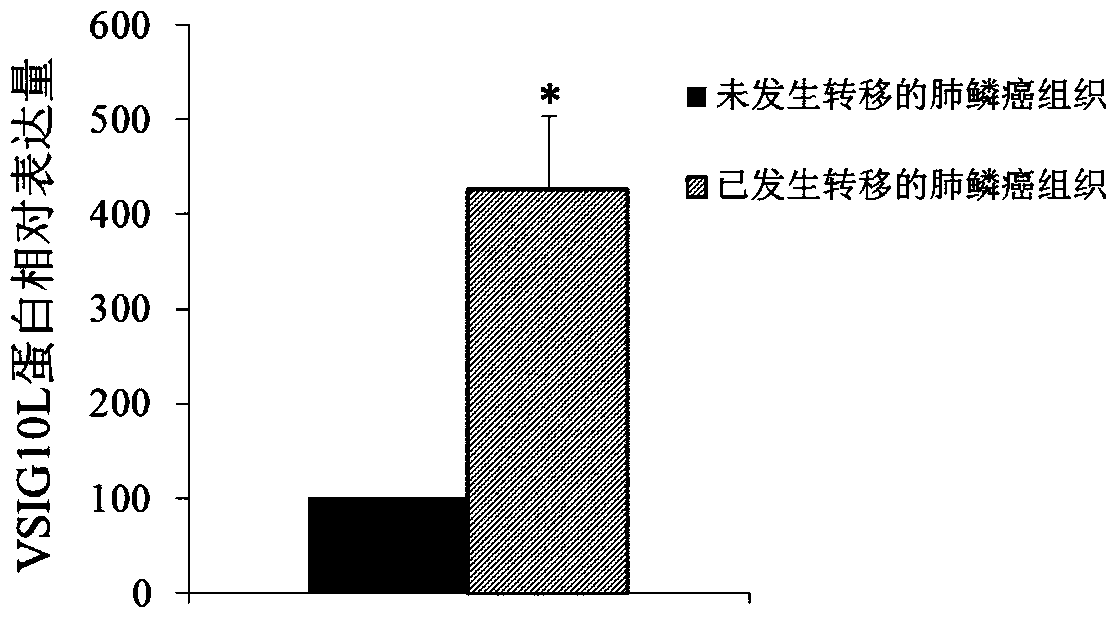Use of vsig10l gene as a marker for the diagnosis and treatment of lung squamous cell carcinoma metastasis
A technology of lung squamous cell carcinoma and genes, which is applied in the determination/testing of microorganisms, medical preparations containing active ingredients, drug combinations, etc. Problems such as high false positive rate
- Summary
- Abstract
- Description
- Claims
- Application Information
AI Technical Summary
Problems solved by technology
Method used
Image
Examples
Embodiment 1
[0062] Example 1 Differential expression of VSIG10L gene
[0063] 1. Sample acquisition: 40 cases of lung squamous cell carcinoma tissues (including 20 samples with metastasis and 20 samples without metastasis). The above samples are surgical resection specimens of patients with lung squamous cell carcinoma. All the above specimens were obtained with the consent of the organizational ethics committee. The clinical data of the tissue samples include: gender, age, tumor size, pathological grade (Edmonson), metastasis or recurrence, etc.
[0064] 2. Acquisition of RNA from lung squamous cell carcinoma metastasis tissue
[0065] The total RNA of metastatic lung squamous cell carcinoma tissue was extracted by Trizol one-step method, and the purity of the RNA solution was determined by reading the absorbance values at 260nm and 280nm by Nanodrop ND-1000 (A). The integrity of RNA was detected by electrophoresis on 1% formaldehyde denatured agarose gel and observed under ultraviol...
Embodiment 2
[0074] Example 2 Differential expression of VSIG10L protein
[0075] 1. The research object is the same as in Example 1.
[0076] 2. Extract tissue total protein
[0077] Follow the instructions of the EpiQuik Tissue / Cell Total Protein Extraction Kit for protein extraction.
[0078] 3. Western blot detection
[0079] The extracted protein was quantitatively subjected to SDS-PAGE electrophoresis, followed by membrane transfer, blocking, primary antibody incubation, secondary antibody incubation, and color development.
[0080] 4. Statistical processing
[0081] The gray value of the protein band was analyzed using Image J software, and the gray value of the VSIG10L protein band was normalized with β-actin as an internal reference. The results and data are expressed in the form of mean ± standard deviation, and SPSS13.0 statistical software is used for statistical analysis. The difference between the two is tested by t test, and it is considered statistically significant whe...
Embodiment 3
[0084] Example 3 Expression of VSIG10L gene in lung squamous cell carcinoma cell lines
[0085] 1. Cell culture
[0086] The lung squamous cell line NCI-H520, NCI-H596, NCI-H2170, NCI-H226 were cultured in DMEM medium and 10% fetal bovine serum, and the human lung epithelial cell line BEAS-2B was cultured in BEGM medium and 10% Cultured in fetal bovine serum at 37°C, 5% CO 2 in the incubator.
[0087] 2. QPCR
[0088] 2.1 Extraction of total cellular RNA: Extraction of total cellular RNA was performed using the RNA extraction kit from QINGEN Company, and performed according to the instruction manual.
[0089] 2.2 Reverse transcription
[0090] The reverse transcription of RNA was carried out using the reverse transcription kit of TAKARA company.
[0091] 2.3 QPCR
[0092] (1) Primer design
[0093] QPCR amplification primers were designed according to the coding sequences of VSIG10L gene and GAPDH gene in Genbank, and synthesized by Shanghai Sangon Bioengineering Techno...
PUM
 Login to View More
Login to View More Abstract
Description
Claims
Application Information
 Login to View More
Login to View More - R&D
- Intellectual Property
- Life Sciences
- Materials
- Tech Scout
- Unparalleled Data Quality
- Higher Quality Content
- 60% Fewer Hallucinations
Browse by: Latest US Patents, China's latest patents, Technical Efficacy Thesaurus, Application Domain, Technology Topic, Popular Technical Reports.
© 2025 PatSnap. All rights reserved.Legal|Privacy policy|Modern Slavery Act Transparency Statement|Sitemap|About US| Contact US: help@patsnap.com



